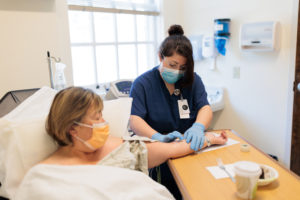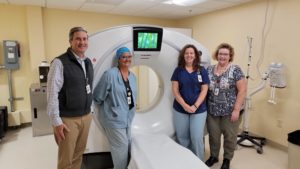

A crane lifts a new HVAC unit for the operating room onto the roof of Gifford Medical Center. The upgraded HVAC unit provides the ability to remotely monitor and adjust air flow, temperature, and humidity in the OR.
Upgrades and Reductions
According to the World Health Organization, a carbon footprint is a measure of the impact your activities have on the amount of carbon dioxide (CO2) produced through the burning of fossil fuels. It’s expressed as the weight of CO2 emissions produced in tons.
Understanding carbon footprint gives a better scope of how our behavior affects global warming. Gifford’s facilities team has made it its mission since 2015 to reduce the carbon footprint at our central Vermont facilities. Over the last six years, through planning and project development for new construction, renovation, installations and upgrades, Gifford has saved around $250,000 and more than 831,000 kilowatt hours.
“Working to minimize the impact of our carbon footprint means something to the staff, and our reputation in the community,” Vice President of Support Services, Doug Pfohl said.
In 2017, Gifford formed an Energy Committee to improve the utilization of resources by promoting sustainability, conservation and investment in the future. The committee is comprised of staff from multiple disciplines to reflect a diversity of views and perspectives. According to Pfohl, efficiency concepts are continuously evaluated, including how the committee can engage employees to provide awareness within the workplace and incorporate a similar mindset in their lifestyles.
“I am a firm believer in conserving energy and saving money,” Gifford Materials Management Supervisor and Energy Committee member, Laura Auszura said. “Being a member of the energy committee allows me to be a part of a group that has the same values. We believe in doing our part to reduce our impact on the environment while saving money for the organization.”
According to Gifford’s Director of Facilities, Patrick Giordano, Gifford has saved an average of 60 tons of carbon a year since 2015. Additionally, through employee engagement and behavior programs, Gifford reduced its electric usage by 8% with Giordano leading the effort.
Replacing a burner in one of its boilers is just one of several examples of how Gifford took another step forward in reducing its carbon footprint this year. Thanks to incentives from Efficiency Vermont, who named Giordano an Energy Champion in 2020, it will only take a little more than five years for the 2021 projects to pay for themselves.

2021 Efficiency Vermont Incentivized Projects Savings
“Efficiency Vermont has been a tremendous partner in identifying the right projects with high incentive rebates and return on investments,” Pfohl said. “These projects are important to an organization like Gifford because we operate around the clock, year round. Utility costs are high. When we offer efficiencies, utility costs go down and savings can be indirectly shared with staff.”
Many of 2021’s projects to reduce Gifford’s carbon footprint were only made possible due to an entire electrical utility service upgrade. When it came to the electrical upgrade, Gifford had a great resource in local design team, DuBois & King. Its mechanical and electrical design services have been invested in Gifford for dozens of years. The facilities team also had plenty of cooperation internally. Working closely with all other departments, the Facilities Team ensured the transition wouldn’t disrupt daily operations.
“We shut down the electricity in every part of this hospital because we had to switch to a new distribution system,” Giordano said. “We would meet with a department or manager a month before we were going to do a scheduled power outage and then two weeks ahead of time to come up with a game plan.”
Once the electrical upgrade was completed, the other projects started to take shape. Gifford replaced an aging 30-ton chiller with a 90-ton chiller. Large commercial buildings like hospitals use chillers to achieve proper temperature control of water. The water is fed through associated heating and cooling equipment that, in turn, sustain Gifford’s interior temperatures.
A pump system was installed along with the chiller. It will allow the chilled water system to maintain the flow necessary to circulate proper pressure and flow to units distant from the chiller plant. The installed pump system is a source for additional efficiency and the first of its kind within the region. The 90-ton chiller and pump system were needed to handle the capacity of a new HVAC unit for the Operating Room (OR) and any future expansions.
“Several units have been operating beyond their useful life, and time has pressed us to develop strong futuristic, energy effective solutions,” Pfohl said.
The work touched every aspect of the Surgical Department. Surgeons had to change their procedure schedules. Patients had to hear some unusual commotion on the roof and staff were moving equipment in and out of rooms. There were constant changes based on the needs of the project.

Arianna Hubbard, RN, prepares a patient’s IV in Gifford’s OR.
“The OR is unpredictable and we had to delay certain phases of the project due to emergent needs in the OR,” Surgical Services Nurse Manager, Caitlyn Welch said. “The reaction to these delays by the facilities and contractor teams were very professional and they all understood that patients come first here at Gifford.”
The upgraded HVAC unit provides the ability to remotely monitor and adjust air flow, temperature and humidity in the OR. Proper temperature, humidity and air exchanges in the OR environment are key in minimizing the risk for infection, proper wound healing, overall patient comfort and satisfaction. If any one of those elements are out of range, the new HVAC system will automatically adjust, and also alert the facilities team via the computerized system.
“This is vital in our day-to-day operations,” Welch said. “This HVAC unit has already proven its capability and reliability in our sterile processing department. There is a history of wide temperature swings in the department, now with the new HVAC unit, the temperature and airflow has stabilized within the proper zones and the staff is more than satisfied with the consistency.”
Another piece of equipment installed thanks to the electrical upgrade, was a brand-new GE Revolution CT scan. The CT scan has twice as many detectors as the previous machine, meaning shortened scan times for patients. Now, outpatients don’t have to wait as long to be scanned and the staff can get to ED patients quicker. Less time in the CT scan also results in a decrease in radiation exposure for the patient. The improved image quality of the scans will help radiologists and providers better determine the diagnosis in a more timely manner.
“The combined effort of facilities, IT and the radiology staff, who all worked well with the outside vendors made the transition quick and seamless,” Radiology Supervisor, Kim Nelson said. “Thanks to the addition of the mobile scan unit, we were able to continue patient care as if the construction was not taking place. It was the great communication between the various departments and the dedication to patient care that made this transition so smooth.”
The electrical upgrade project completed this year has already proven its benefit to nurses, providers, and patients on the floor. It will help balance the bottom line and is a positive for the environment. One more added plus to reducing Gifford’s carbon footprint is the Gifford team coming together for the cause.
“I think we all view it as the right thing to do,” Auszura said. “Gifford takes pride in serving the community in many ways. Reducing our carbon footprint doesn’t just benefit Gifford, it benefits the entire community.”

Dr. Jeffrey Bath stands in front of Gifford’s new CT scan with Gifford Radiology Technologists, Anna Marisseau and Cheryl Jewkes, along with Director of Ancillary Services, Pam Caron.
“That’s the beauty of being at Gifford,” Giordano said. “From managers to staff on the floor interrupting their jobs, people get it and they are looking forward to the completed projects and being a part of it. It’s pretty awesome.”There are more equipment replacements to come in the future. Pfohl says the goal is to upgrade all the equipment on the medical center’s roof in the next four years, which will allow Gifford to operate more of its HVAC cooling systems from chillers. Upgrading with newer energy-efficient equipment is an investment, costing money now, but saving money in the long run.
“The money saved can be put back into the facility and the community,” Giordano said. “The reduction of our carbon footprint will lead to a healthier environment, which is another way Gifford maintains its commitment to keeping our community’s health a priority.”

